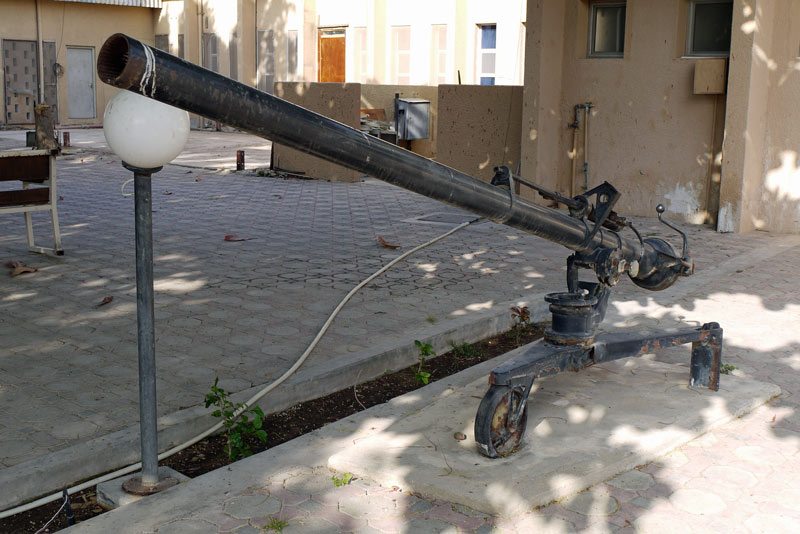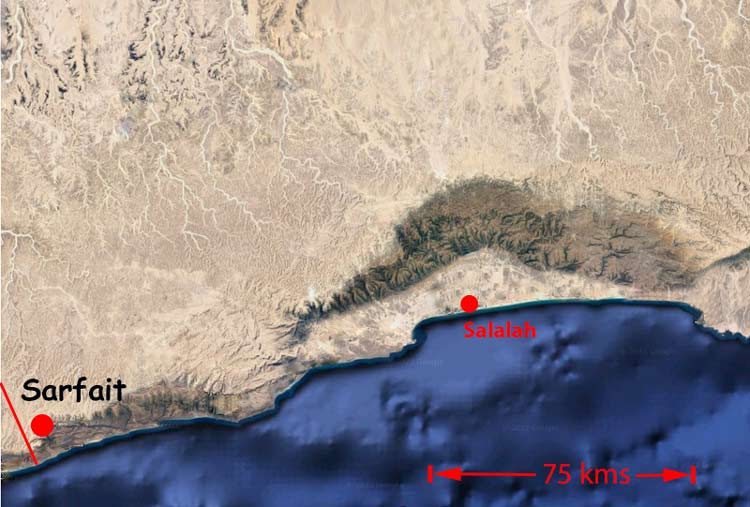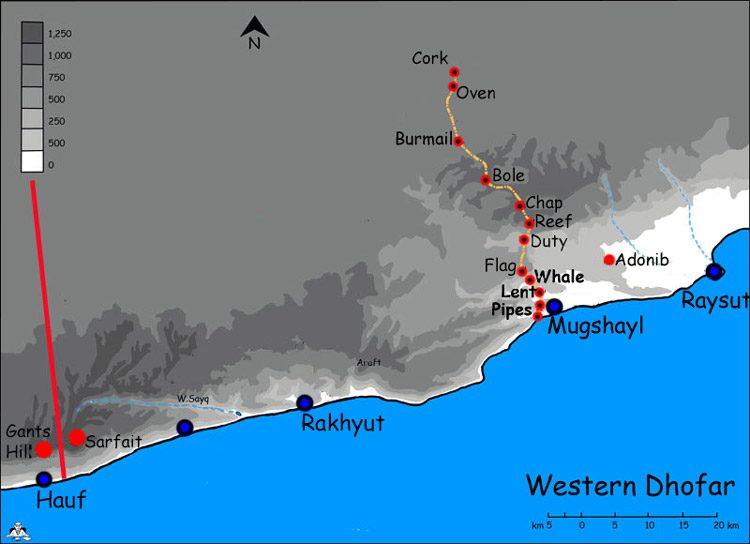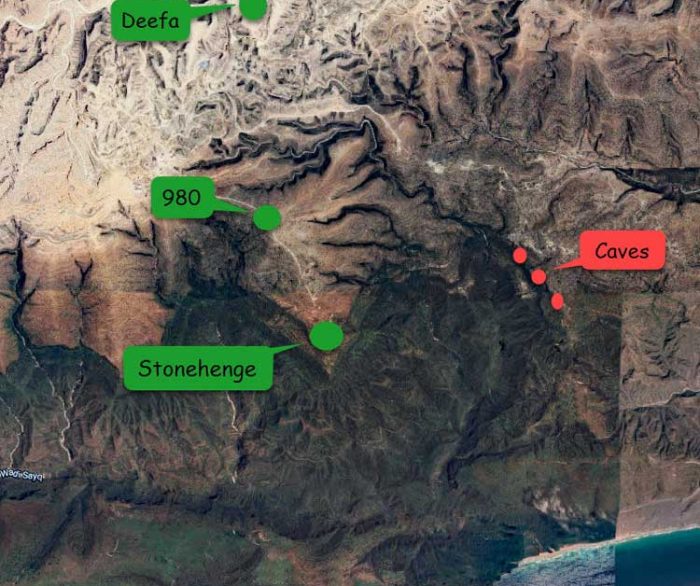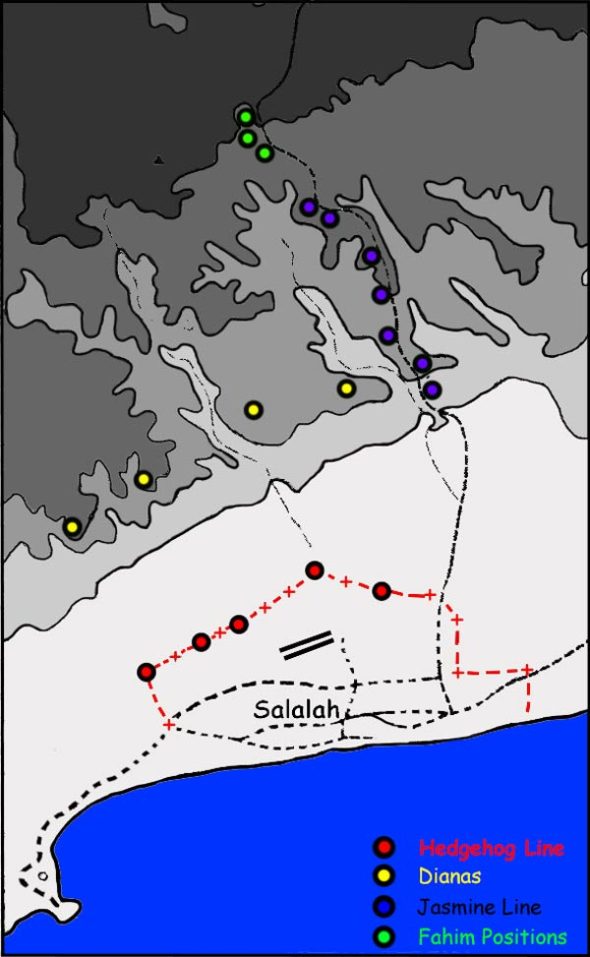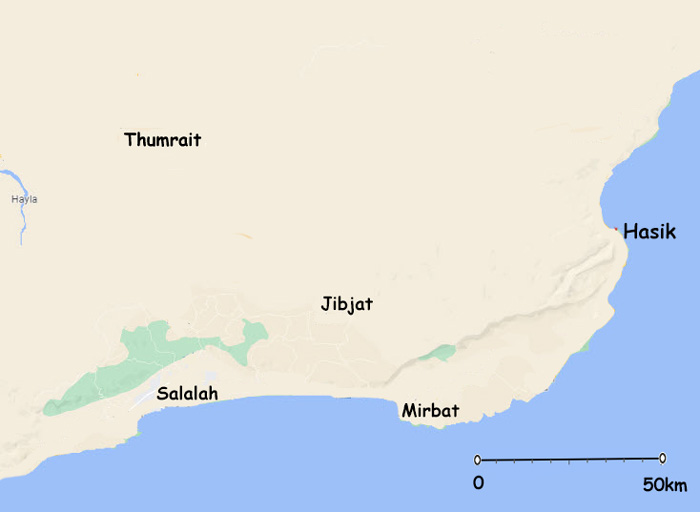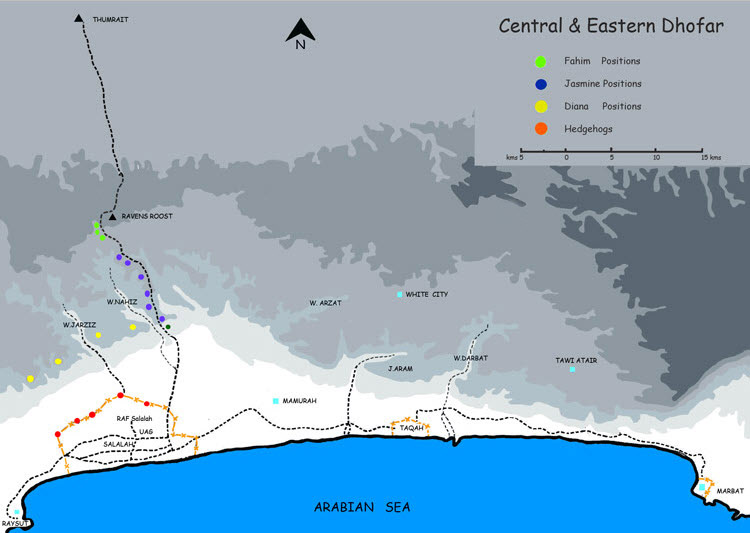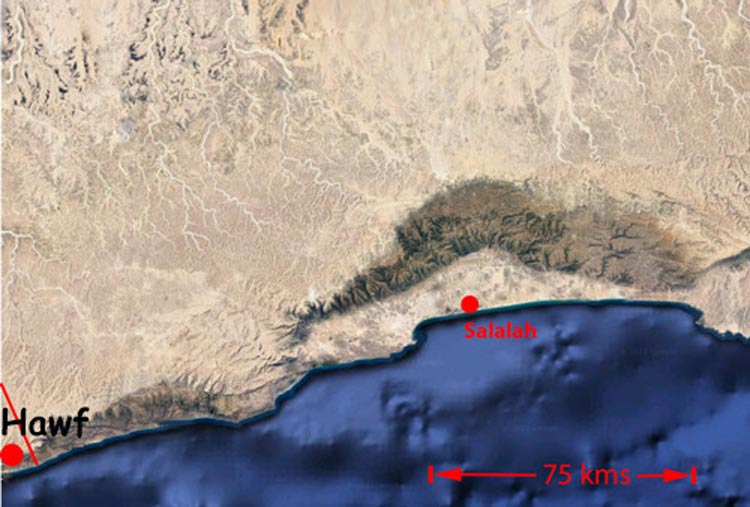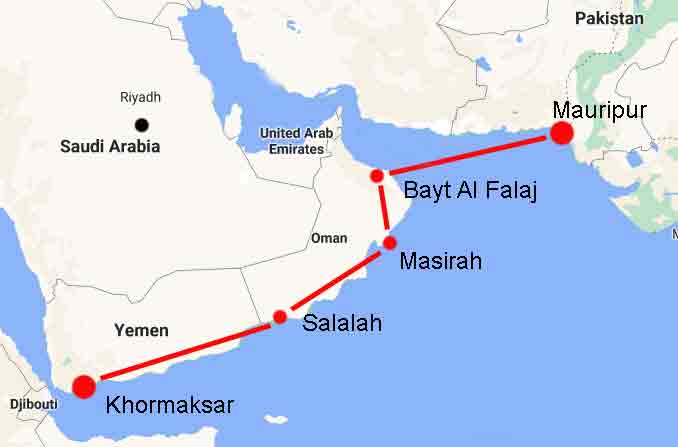The basis of this account is an unclassified document used in a presentation for those revisiting the battlefield a few years ago and again in December 2010.There are many accounts of the battle and this one has simply been used as a framework and must be regarded as such rather than a definitive account.
There are many other accounts some of which are clearly contradictory e.g. Were bombs dropped by the Strikemasters ? An account by one of the participants on the ground describes a 500kg bomb being dropped and a “thunderous explosion”
The three pilots I spoke to said they were not armed with bombs as they were flying too low and exploding bombs would have put their aircraft at risk (!).
After forty years there may possibly be a degree of confabulation present in some of the accounts that follow. There are reported to be contempraneous unpublished post-engagement reports written by BATT, SAF and SOAF which would have great credibility in establishing the historical facts but for reasons best known to their custodians they remain unavailable to the wider audience who have an interest in the battle. It is for the reader to make their own assessment from the limited resources that are available.
The enemy PFLOAG had something of a setback in October 1971 when Operation Jaguar succeeded in establishing a firm base at Jibjat. They assumed that the BATT outpost in Mirbat was only a medical team and that they would be able to overwhelm it with relative ease. They calculated that the khareef would so hinder flying operations, because of a low mist, that the helicopters and the Strikemasters would be rendered ineffective.
They therefore assembled a core force from Yemen of about 400 men. However one of their firqa leaders entered into a dispute as it happened and withdrew a 100 or so of his men and scuttled off back up the jebel.
The adoo intended to approach from the North and the East by way of the wadis and capture Mirbat town. They intended to hold it for a day, denounce and execute the wali and his advisors, spread propaganda and then retreat to the jebel. If this had been achieved the townspeople would have been terrified of supporting the sultan as they would have no confidence that the sultans forces could protect them. Civil government would break down as no one would have the courage to take up administrative posts.
The resident Firqa Force were not aware that the adoo were about to attack. Their purpose at Mirbat was both for training and for operations against the adoo. They were there to support the government’s regular forces and their administrative representatives in the town.
Two days before the battle the adoo engineered a confrontation on the edge of the Jebel Samhan to draw out the Firqa and BATT.
Moving over the jebel in groups of 40, from the west, they laid out a security screen in front of them to clear the villages and round up recruits. On the night of the 18/19th July they gathered in the Wadi Ghazir. They were well armed and amongst their weapons were 75mm RCLs, Spahghin HMGs, 2″ and 3″ mortars and other medium machine guns. They intended to start their attack at 03:00 and move from the Wadi Ghazir along to Mirbat. There were some holdups but the SAF picquet on the Jebel Ali was silenced.
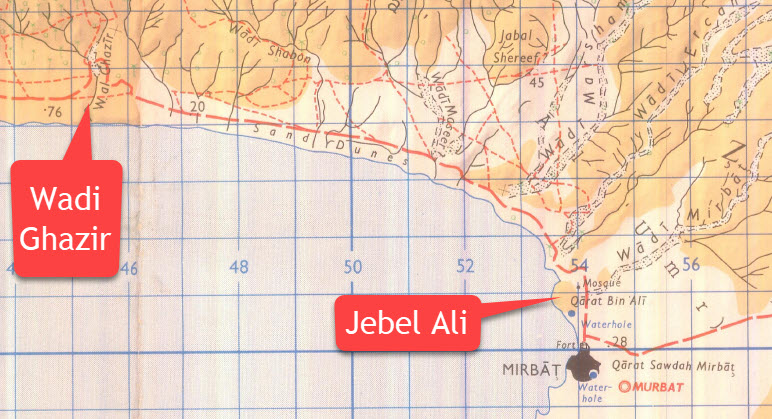
It can be seen that the Wadi Ghazir is about 10kms from Mirbat and that the Jebel Ali is only 1km from Mirbat. The photograph below was taken during the Veterans Tour in 2010 and shows the Jebeli Ali in the middleground and the Jebel Samahan in the background. Note that Toyota Landcruisers have supplanted Landrovers as the favoured make of transport.
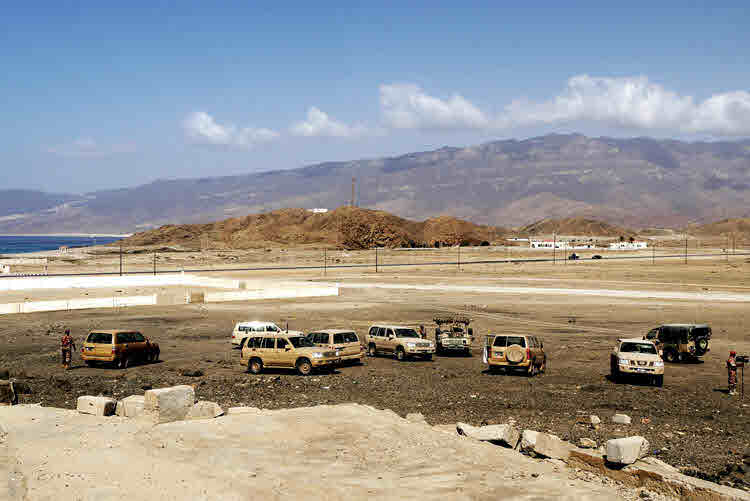
The intention was to advance on the defences over the border wire and capture the 25pdr artillery piece at the Fort which they could then turn on the town. The main action in the battle centred around the BATT House and the Fort with the 25pdr.
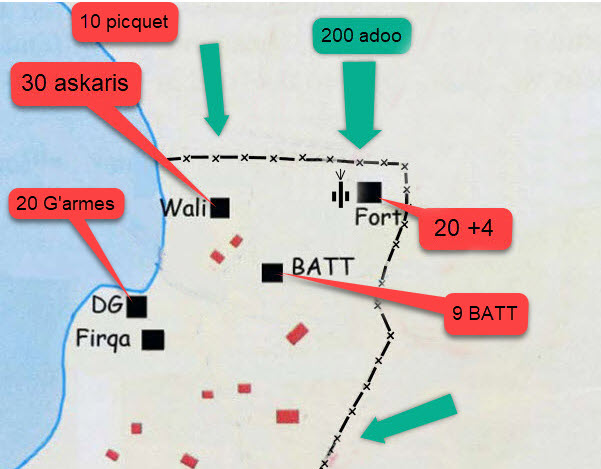
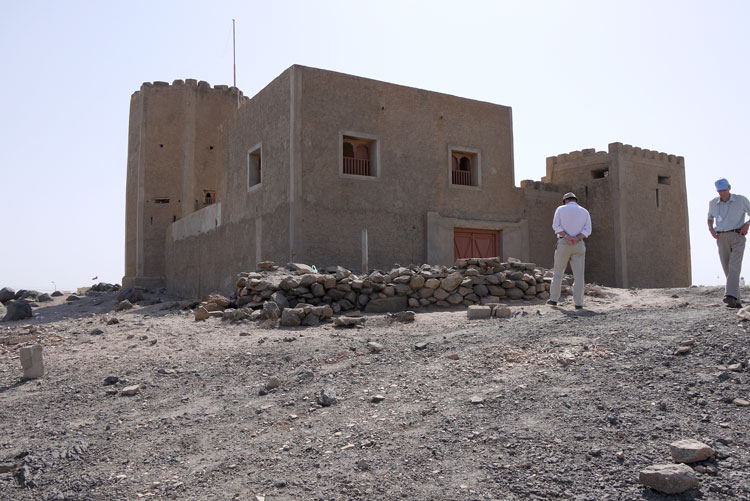
The BATT forces soon to be defending Mirbat numbered nine including Capt Mike Kealy their commander.
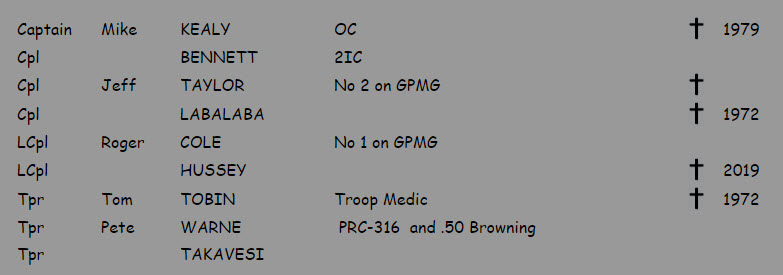
In addition to their personal weapons they had very little additional armament; one 81mm mortar, a 0.5″ Browning MG and a 7.62 GPMG.
The members of BATT in Mirbat had been celebrating the end of their tour in Dhofar with some hoarded G10 rum and were looking forward to their relief by G squadron later that morning.They had a late night listening to loud music and then had an unexpected early morning awakening.
The Dhofar Gendamerie, who were Northern tribesmen armed with .303 rifles, formed a picquet ten strong on the Jebel Ali and twenty strong in the DG Fort[2]
The 25 pdr gun at the DG fort was manned by four members of the Oman artillery.
In the west at the Na’ib Wali’s fort there were thirty local militia or askars armed with .303 Lee Enfield rifles and Martini-Henry rifles.[3]
At around 05:30 the adoo attacked the DG positions on the Jebel Ali and killed all of the GD picquet bar two who escaped back towards the town.
They established Heavy (12.7mm) MG positions on the Jebel Ali with which they could fire on the town or at aircraft. The threat from aircraft at this point was minimal as the khareef cloud and mist had reduced the cloud level to 150 feet.
The adoo formed up in their assault positions and moved in groups of ten or so towards the town. Larger groups of about twenty gathered in front of the DG fort. The 25pdr was being fired over open sights towards the enemy who were as near as 40m away attempting to climb over the wire in front of the fort (this wire has been described as little more than a very robust cattle fence)[4]
All of the gun crew were wounded until only Gunner Walid Khamis of the Oman Artillery remained active.[5]
A BATT member, Labalaba, ran to the DG fort to help man the 25 pdr gun. However he was soon hit in the chin, or “chinned” as he described it over the radio. Takavesi ran straight to the gunpit from the BATT house under heavy fire to support Labalaba.
Kealy contacted BATT HQ at Umm al Gwarif and requested casevac for Labalaba and air to ground support when the cloud base was high enough to make it possible.
There was now no radio contact with the gunpit. Kealy realised that was the centre of action and where, as commander of the BATT he should be. He transferred command of the BATT house to Bennett, changed out of his flip flops (!), and, accompanied by Tom Tobin the BATT medic, took the slightly more circuitous route along a shallow wadi to the back of the DG fort 500m away. During the run they were spotted and engaged by an adoo machine gunner. However they finally reached the ammo pit just behind the 25 pdr
Tobin then gave Gnr Walid Khamis first aid whilst the seriously wounded Labalaba crawled back to the ammo pit and told Kealy that Takavesi is also seriously wounded in the shoulder back and head but still giving covering fire from the gunpit.
(Meanwhile) Adoo now pierced the wire – running up to the fort
Laba returns to the gun and turns it right and fires over open sights.
Killed by shot through neck.
Enemy closes the position.
Grenades.
Tobin hit – mortally wounded.[6]
Kealy tells Bennett to fire his MGs and mortars onto the fort.
Tells Kealy that Strikemasters on the way
Dud grenade falls into ammo pit with Kealy
Strikemasters arrive and strafe from West with rockets and machine gun fire.
Adoo take cover behind far side of fort.[7]
The record states that now there was a lull(!) and Kealy moved over to the gunpit to find ‘Tak leaning against gun pit covering left side of fort seriously wounded but still in action.
Laba dead.
Tobin unconscious.
Not sure who held fort’
LCpl Hussey joined Kealy in the gunpit.
Strikemasters attack the Jebel Ali.
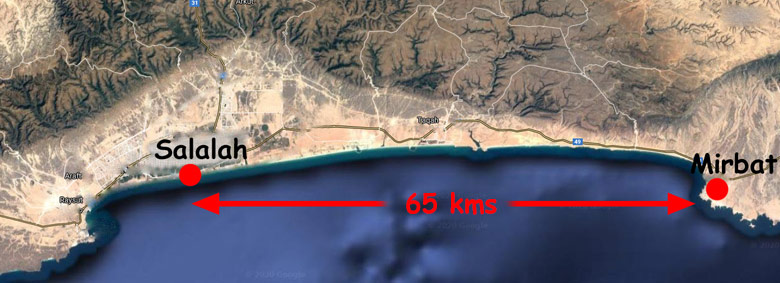

By 09:30 ‘G’ Sqn Gp arrived SE of Mirbat behind the enemy.
“Debuses and bounds towards the town killing as they go”
Firquat had deployed in threes behind rocks to the east of the town to prevent the enemy from getting in.
Adoo were now caught between Firquat and advancing ‘G’ Sqn.
Kealy was worried about “blue on blue”
A helicopter was then flown to the back of the fort for casevac.
Tobin and Gnr Walid Khamis loaded in.
Tak declined to be carried and walks to heli.

In the aftermath of the Veterans Tour to Oman in December 2010 one officer (GA) e-mailed the following observation to me :
“I’m not really one for re-reading very low level tactics years later: perspectives are always so very personal”.
With that firmly in mind this account may be as accurate as any other.
Mirbat Fort
The slope from the wire in front of the fort is quite steep. This video shows the gunpit at the top beside the fort and the steepness of the slope from where the LandCruisers were parked – approximately where the wire was. Anyone approaching the fort from the NE would have been sheltered from the BATT house and the Walis Fort especially when they came close in.
This video is in *.wmv format with a file size of 13MbClick edit button to change this text.
Video not yet embedded 6/7/19
SOAF and Mirbat
The SOAF contribution to Marbat was crucial and is outlined on the web page attached to this section.
Page incomplete 07/03/20
The Adoo Viewpoint
One interesting point in this narrative does suggest that the adoo had established some sort of medical support team with certainly one designated first aider – Waleed – and some regular assistants to help him.
A former member of the adoo, present on that day, related to one of the British Officers [PS] many years later in London that the casualty toll, when those who had died of their wounds had been included, was in the region of 200.
The other point undoubtedly being the despairing observation.
“Then the planes came”
Page completed 06/07/19
‘Debrief’ of the Adoo prisoners
Immediately after the battle three adoo prisoners were taken to Umm Al Ghwarriff and were debriefed in an attempt to obtain information that would be immediately useful to those still at Marbat.
Page completed 06/07/19
The Omani Viewpoint.
There is a brief account in the SAF Museum at Bait al Falaj.
Page completed 07/07/19
Awards for Bravery.
A number of awards were made for bravery to those who took part in the battle. There are many who believe that because of the secrecy surrounding the war and the political desire to downplay British involvement the awards did not reflect the outstanding bravery shown by those involved.
Page completed 23/01/2021
Adoo weaponry at Mirbat.
A list of the weapons used by the adoo in the assault on Mirbat
[ 1 ] There are many accounts of the Battle of Mirbat. The basis for this account is an unclassified document used at a battlefield presentation some years ago. Other factual comments have been added from other sources. The webmaster has only included those that he believes to be accurate and from a reliable source. As far as possible I have tried to avoid “opinion” and present only fact. There will inevitably be conflict within this document and with other accounts of the battle elsewhere.[BdeB]
[ 2 ] Their part in the battle is not recorded [PW] but it has been stated that they were unsure of their role on account of a failure in communications[VT]
[ 3 ] Fifty firqa from the Firqat Al Umri were based at the fort and were on patrol “up the jebel” at the commencement of the battle [PW]
[ 4 ] In the early stages of the battle the gun fired on registered targets i.e. known approach routes and the adoo mortar line. In the later stages the adoo was too close to get the (required) depression on the gun barrel. It became more a weapon of intimidation, forcing the adoo to keep their heads down as artillery rounds whistled over their heads [PW]
[ 5 ] I cannot identify in the anaesthetic records which of the wounded treated in the FST were Omani artillery other than Walid Khamis /Khalfan.[BdeB]
The only record I can find is the citation for the Sultan’s Gallantry Medal.[BdeB] The point in the battle at which he was injured is not made clear in that citation [PW]
His wounds were serious and the anaesthetic record card indicates that he had several GSW (Gunshot Wound Injuries) including one to the cauda equina which paralysed him from the knees downwards as the nerves in that part of his spine had been damaged. Following such an injury he would not have been able to walk. There was also abdominal trauma which would have further debilitated him for which he later required a laparotomy. His condition was such that he was prioritised in the triage system after Tpr Tobin and before Tpr Takavesi whose injuries were also very severe. The time of his injury is recorded as 05.00hrs. [BdeB] This may very well be inaccurate; The anaesthetic record cards are contempaneous and accurate as far as the clinical detail is concerned whilst the patients were in the care of the anaesthetist. However the area on the front panel to the bottom left records what we were told about the circumstances of the injury and are therefore hearsay where accuracy cannot be guaranteed.
[ 6 ] This might imply that Tom Tobin died soon after his multiple and serious injuries. This was not the case. He was evacuated to the UK and died many weeks later perhaps from complications arising from a tooth being forced deep into his lungs when he was hit in the jaw.[BdeB] One book (OS) relates that whilst in hospital soon before his death in October 1972 a thoracotomy was performed to try and remove the tooth fragment. One of the members of the VT(2010) recalls going to see him in hospital but although he stayed for an hour was unable to raise any response from him [RL-VT-2010] This might imply that the blast wave from the high velocity bullet that smashed his mandible and passed close to his brain caused bTBI (traumatic Brian injury due to blast)The effects of blast on his lungs has never been mentioned in his case. There was perhaps more to it that a simple tooth fragment.
Consideration has perhaps not been given to the observations of the American trauma surgeon, Dr R Adams Cowley, from Maryland University who made the observation “There is a golden hour between life and death. If you are critically injured you have less than 60 minutes to survive. You might not die right then; it may be three days or two weeks later — but something has happened in your body that is irreparable.”
This observation has to be tempered and the stance taken that your chances of immediate survival will be very much better if you are seen within that time span. There is still the complex cytokine storm which causes changes that have been reviewed from a cohort of some 2.7 million American servicemen who were subject to blast. It was recorded as being significant 315 days after injury.
The hyper-active inflammatory response that may be triggered at the instant of injury may be what kills later on. (Emily Maitlis “The Heavy Reckoning”)
This may be so with Tom Tobin. His first definitive treatment occurred hours after he was injured. Outside the Golden Hour. Quite without evidence one might suggest that earlier intervention might have reduced the level of long term damage initiated by this response.
The cytokine storm came to public notice during the Covid pandemic and all sorts of therapies were promoted to try and stop it Donald Trump even suggested bleach, sunshine and hydroxychloroquine. The only medication that trained and experienced physicians reviewed and showed to have any effect was old-fashioned dexamethasone. Maybe there is something else out there that if given at the time of injury or soon after will prevent this inflammatory storm rampaging through the body ?
[ 7 ] Nobby Grey’s account in “SOAF & Marbat” describes the Strikemasters’ role in considerable detail.
